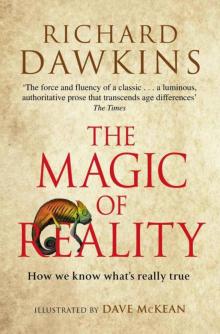- Home
- Richard Dawkins
The Selfish Gene Page 30
The Selfish Gene Read online
Page 30
Football is a zero sum game. At least, it usually is. Occasionally it can become a nonzero sum game. This happened in 1977 in the English Football League (Association Football or 'Soccer'; the other games called football-Rugby Football, Australian Football, American Football, Irish Football, etc., are also normally zero sum games). Teams in the Football League are split into four divisions. Clubs play against other clubs within their own division, accumulating points for each win or draw throughout the season. To be in the First Division is prestigious, and also lucrative for a club since it ensures large crowds. At the end of each season, the bottom three clubs in the First Division are relegated to the Second Division for the next season. Relegation seems to be regarded as a terrible fate, worth going to great efforts to avoid.
May 18th 1977 was the last day of that year's football season. Two of the three relegations from the First Division had already been determined, but the third relegation was still in contention. It would definitely be one of three teams, Sunderland, Bristol, or Coventry. These three teams, then, had everything to play for on that Saturday. Sunderland were playing against a fourth team (whose tenure in the First Division was not in doubt). Bristol and Coventry happened to be playing against each other. It was known that, if Sunderland lost their game, then Bristol and Coventry needed only to draw against each other in order to stay in the First Division. But if Sunderland won, then the team relegated would be either Bristol or Coventry, depending on the outcome of their game against each other. The two crucial games were theoretically simultaneous. As a matter of fact, however, the Bristol-Coventry game happened to be running five minutes late. Because of this, the result of the Sunderland game became known before the end of the Bristol-Coventry game. Thereby hangs this whole complicated tale.
For most of the game between Bristol and Coventry the play was, to quote one contemporary news report, 'fast and often furious', an exciting (if you like that sort of thing) ding-dong battle. Some brilliant goals from both sides had seen to it that the score was 2-all by the eightieth minute of the match. Then, two minutes before the end of the game, the news came through from the other ground that Sunderland had lost. Immediately, the Coventry team manager had the news flashed up on the giant electronic message board at the end of the ground. Apparently all 22 players could read, and they all realized that they needn't bother to play hard any more. A draw was all that either team needed in order to avoid relegation. Indeed, to put effort into scoring goals was now positively bad policy since, by taking players away from defence, it carried the risk of actually losing-and being relegated after all. Both sides became intent on securing a draw. To quote the same news report: 'Supporters who had been fierce rivals seconds before when Don Gillies fired in an 80th minute equaliser for Bristol, suddenly joined in a combined celebration. Referee Ron Challis watched helpless as the players pushed the ball around with little or no challenge to the man in possession.' What had previously been a zero sum game had suddenly, because of a piece of news from the outside world, become a nonzero sum game. In the terms of our earlier discussion, it is as if an external 'banker' had magically appeared, making it possible for both Bristol and Coventry to benefit from the same outcome, a draw.
Spectator sports like football are normally zero sum games for a good reason. It is more exciting for crowds to watch players striving mightily against one another than to watch them conniving amicably. But real life, both human life and plant and animal life, is not set up for the benefit of spectators. Many situations in real life are, as a matter of fact, equivalent to nonzero sum games. Nature often plays the role of 'banker', and individuals can therefore benefit from one another's success. They do not have to do down rivals in order to benefit themselves. Without departing from the fundamental laws of the selfish gene, we can see how cooperation and mutual assistance can flourish even in a basically selfish world. We can see how, in Axelrod's meaning of the term, nice guys may finish first.
But none of this works unless the game is iterated. The players must know (or 'know') that the present game is not the last one between them. In Axelrod's haunting phrase, the 'shadow of the future' must be long. But how long must it be? It can't be infinitely long. From a theoretical point of view it doesn't matter how long the game is; the important thing is that neither player should know when the game is going to end. Suppose you and I were playing against each other, and suppose we both knew that the number of rounds in the game was to be exactly 100. Now we both understand that the 100th round, being the last, will be equivalent to a simple one-off game of Prisoner's Dilemma. Therefore the only rational strategy for either of us to play on the 100th round will be defect, and we can each assume that the other player will work that out and be fully resolved to defect on the last round. The last round can therefore be written off as predictable. But now the 99th round will be the equivalent of a one-off game, and the only rational choice for each player on this last but one game is also defect. The 98th round succumbs to the same reasoning, and so on back. Two strictly rational players, each of whom assumes that the other is strictly rational, can do nothing but defect if they both know how many rounds the game is destined to run. For this reason, when games theorists talk about the Iterated or Repeated Prisoner's Dilemma game, they always assume that the end of the game is unpredictable, or known only to the banker.
Even if the exact number of rounds in the game is not known for certain, in real life it is often possible to make a statistical guess as to how much longer the game is likely to last. This assessment may become an important part of strategy. If I notice the banker fidget and look at his watch, I may well conjecture that the game is about to be brought to an end, and I may therefore feel tempted to defect. If I suspect that you too have noticed the banker fidgeting, I may fear that you too may be contemplating defection. I will probably be anxious to get my defection in first. Especially since I may fear that you are fearing that I. ..
The mathematician's simple distinction between the one-off Prisoner's Dilemma game and the Iterated Prisoner's Dilemma game is too simple. Each player can be expected to behave as if he possessed a continuously updated estimate of how long the game is likely to go on. The longer his estimate, the more he will play according to the mathematician's expectations for the true iterated game: in other words, the nicer, more forgiving, less envious he will be. The shorter his estimate of the future of the game, the more he will be inclined to play according to the mathematician's expectations for the one-off game: the nastier, and less forgiving will he be. Axelrod draws a moving illustration of the importance of the shadow of the future from a remarkable phenomenon that grew up during the First World War, the so-called live-and-let-live system. His source is the research of the historian and sociologist Tony Ashworth. It is quite well known that at Christmas British and German troops briefly fraternized and drank together in no-man's-land. Less well known, but in my opinion more interesting, is the fact that unofficial and unspoken nonaggression pacts, a 'live-and-let-live' system, flourished all up and down the front lines for at least two years starting in 1914. A senior British officer, on a visit to the trenches, is quoted as being astonished to observe German soldiers walking about within rifle range behind their own line. 'Our men appeared to take no notice. I privately made up my mind to do away with that sort of thing when we took over; such things should not be allowed. These people evidently did not know there was a war on. Both sides apparently believed in the policy of "live-and-let-live".' The theory of games and the Prisoner's Dilemma had not been invented in those days but, with hindsight, we can see pretty clearly what was going on, and Axelrod provides a fascinating analysis. In the entrenched warfare of those times, the shadow of the future for each platoon was long. That is to say, each dug-in group of British soldiers could expect to be facing the same dug-in group of Germans for many months. Moreover, the ordinary soldiers never knew when, if ever, they were going to be moved; army orders are notoriously arbitrary, capricious and incomprehensible to those recei
ving them. The shadow of the future was quite long enough, and indeterminate enough, to foster the development of a Tit for Tat type of cooperation. Provided, that is, that the situation was equivalent to a game of Prisoner's Dilemma.
To qualify as a true Prisoner's Dilemma, remember, the payoffs have to follow a particular rank order. Both sides must see mutual cooperation (CC) as preferable to mutual defection. Defection while the other side cooperates (DC) is even better if you can get away with it. Cooperation while the other side defects (CD) is worst of all. Mutual defection (DD) is what the general staff would like to see. They want to see their own chaps, keen as mustard, potting Jerries (or Tommies) whenever the opportunity arises.
Mutual cooperation was undesirable from the generals' point of view, because it wasn't helping them to win the war. But it was highly desirable from the point of view of the individual soldiers on both sides. They didn't want to be shot. Admittedly-and this takes care of the other payoff conditions needed to make the situation a true Prisoner's Dilemma-they probably agreed with the generals in preferring to win the war rather than lose it. But that is not the choice that faces an individual soldier. The outcome of the entire war is unlikely to be materially affected by what he, as an individual, does. Mutual cooperation with the particular enemy soldiers facing you across no-man's-land most definitely does affect your own fate, and is greatly preferable to mutual defection, even though you might, for patriotic or disciplinary reasons, marginally prefer to defect (DC) if you could get away with it It seems that the situation was a true prisoner's dilemma. Something like Tit for Tat could be expected to grow up, and it did.
The locally stable strategy in any particular part of the trench lines was not necessarily Tit for Tat itself. Tit for Tat is one of a family of nice, retaliatory but forgiving strategies, all of which are, if not technically stable, at least difficult to invade once they arise. Three Tits for a Tat, for instance, grew up in one local area according to a contemporary account.
We go out at night in front of the trenches... The German working parties are also out, so it is not considered etiquette to fire. The really nasty things are rifle grenades ... They can kill as many as eight or nine men if they do fall into a trench ... But we never use ours unless the Germans get particularly noisy, as on their system of retaliation three for every one of ours come back.
It is important, for any member of the Tit for Tat family of strategies, that the players are punished for defection. The threat of retaliation must always be there. Displays of retaliatory capability were a notable feature of the live-and-let-live system. Crack shots on both sides would display their deadly virtuosity by firing, not at enemy soldiers, but at inanimate targets close to the enemy soldiers, a technique also used in Western films (like shooting out candle flames). It does not seem ever to have been satisfactorily answered why the two first operational atomic bombs were used-against the strongly voiced wishes of the leading physicists responsible for developing them-to destroy two cities instead of being deployed in the equivalent of spectacularly shooting out candles.
An important feature of Tit for Tat-like strategies is that they are forgiving. This, as we have seen, helps to damp down what might otherwise become long and damaging runs of mutual recrimination. The importance of damping down retaliation is dramatized by the following memoir by a British (as if the first sentence left us in any doubt) officer:
I was having tea with A company when we heard a lot of shouting and went to investigate. We found our men and the Germans standing on their respective parapets. Suddenly a salvo arrived but did no damage. Naturally both sides got down and our men started swearing at the Germans, when all at once a brave German got on to his parapet and shouted out 'We are very sorry about that; we hope no one was hurt. It is not our fault, it is that damned Prussian artillery.'
Axelrod comments that this apology 'goes well beyond a merely instrumental effort to prevent retaliation. It reflects moral regret for having violated a situation of trust, and it shows concern that someone might have been hurt.' Certainly an admirable and very brave German.
Axelrod also emphasizes the importance of predictability and ritual in maintaining a stable pattern of mutual trust. A pleasing example of this was the 'evening gun' fired by British artillery with clockwork regularity at a certain part of the line. In the words of a German soldier:
At seven it came-so regularly that you could set your watch by it... It always had the same objective, its range was accurate, it never varied laterally or went beyond or fell short of the mark... There were even some inquisitive fellows who crawled out... a little before seven, in order to see it burst.
The German artillery did just the same thing, as the following account from the British side shows:
So regular were they [the Germans] in their choice of targets, times of shooting, and number of rounds fired, that... Colonel Jones ... knew to a minute where the next shell would fall. His calculations were very accurate, and he was able to take what seemed to uninitiated Staff Officers big risks, knowing that the shelling would stop before he reached the place being shelled.
Axelrod remarks that such 'rituals of perfunctory and routine firing sent a double message. To the high command they conveyed aggression, but to the enemy they conveyed peace.'
The live-and-let-live system could have been worked out by verbal negotiation, by conscious strategists bargaining round a table. In fact it was not. It grew up as a series of local conventions, through people responding to one another's behaviour; the individual soldiers were probably hardly aware that the growing up was going on. This need not surprise us. The strategies in Axelrod's computer were definitely unconscious. It was their behaviour that defined them as nice or nasty, as forgiving or unforgiving, envious or the reverse. The programmers who designed them may have been any of these things, but that is irrelevant. A nice, forgiving, non-envious strategy could easily be programmed into a computer by a very nasty man. And vice versa. A strategy's niceness is recognized by its behaviour, not by its motives (for it has none) nor by the personality of its author (who has faded into the background by the time the program is running in the computer). A computer program can behave in a strategic manner, without being aware of its strategy or, indeed, of anything at all.
We are, of course, entirely familiar with the idea of unconscious strategists, or at least of strategists whose consciousness, if any, is irrelevant. Unconscious strategists abound in the pages of this book. Axelrod's programs are an exellent model for the way we, throughout the book, have been thinking of animals and plants, and indeed of genes. So it is natural to ask whether his optimistic conclusions-about the success of non-envious, forgiving niceness-also apply in the world of nature. The answer is yes, of course they do. The only conditions are that nature should sometimes set up games of Prisoner's Dilemma, that the shadow of the future should be long, and that the games should be nonzero sum games. These conditions are certainly met, all round the living kingdoms.
Nobody would ever claim that a bacterium was a conscious strategist, yet bacterial parasites are probably engaged in ceaseless games of Prisoner's Dilemma with their hosts and there is no reason why we should not attribute Axelrodian adjectives-forgiving, non-envious, and so on-to their strategies. Axelrod and Hamilton point out that normally harmless or beneficial bacteria can turn nasty, even causing lethal sepsis, in a person who is injured. A doctor might say that the person's 'natural resistance' is lowered by the injury. But perhaps the real reason is to do with games of Prisoner's Dilemma. Do the bacteria, perhaps, have something to gain, but usually keep themselves in check? In the game between human and bacteria, the 'shadow of the future' is normally long since a typical human can be expected to live for years from any given starting-point. A seriously wounded human, on the other hand, may present a potentially much shorter shadow of the future to his bacterial guests. The 'Temptation to defect' correspondingly starts to look like a more attractive option than the 'Reward for mutual cooperation'. Needles
s to say, there is no suggestion that the bacteria work all this out in their nasty little heads! Selection on generations of bacteria has presumably built into them an unconscious rule of thumb which works by purely biochemical means.
Plants, according to Axelrod and Hamilton, may even take revenge, again obviously unconsciously. Fig trees and fig wasps share an intimate cooperative relationship. The fig that you eat is not really a fruit. There is a tiny hole at the end, and if you go into this hole (you'd have to be as small as a fig wasp to do so, and they are minute: thankfully too small to notice when you eat a fig), you find hundreds of tiny flowers lining the walls. The fig is a dark indoor hothouse for flowers, an indoor pollination chamber. And the only agents that can do the pollinating are fig wasps. The tree, then, benefits from harbouring the wasps. But what is in it for the wasps? They lay their eggs in some of the tiny flowers, which the larvae then eat. They pollinate other flowers within the same fig. 'Defecting', for a wasp, would mean laying eggs in too many of the flowers in a fig and pollinating too few of them. But how could a fig tree 'retaliate'? According to Axelrod and Hamilton, 'It turns out in many cases that if a fig wasp entering a young fig does not pollinate enough flowers for seeds and instead lays eggs in almost all, the tree cuts off the developing fig at an early stage. All progeny of the wasp then perish.'
A bizarre example of what appears to be a Tit for Tat arrangement in nature was discovered by Eric Fischer in a hermaphrodite fish, the sea bass. Unlike us, these fish don't have their sex determined at conception by their chromosomes. Instead, every individual is capable of performing both female and male functions. In any one spawning episode they shed either eggs or sperm. They form monogamous pairs and, within the pair, take turns to play the male and female roles. Now, we may surmise that any individual fish, if it could get away with it, would 'prefer' to play the male role all the time, because the male role is cheaper. Putting it another way, an individual that succeeded in persuading its partner to play the female most of the time would gain all the benefits of 'her' economic investment in eggs, while 'he' has resources left over to spend on other things, for instance on mating with other fish.

 The Magic of Reality
The Magic of Reality The Extended Phenotype
The Extended Phenotype The God Delusion
The God Delusion The Selfish Gene
The Selfish Gene The Blind Watchmaker
The Blind Watchmaker The Greatest Show on Earth
The Greatest Show on Earth Climbing Mount Improbable
Climbing Mount Improbable Outgrowing God
Outgrowing God Brief Candle in the Dark
Brief Candle in the Dark The Greatest Show on Earth: The Evidence for Evolution
The Greatest Show on Earth: The Evidence for Evolution Science in the Soul
Science in the Soul An Appetite for Wonder
An Appetite for Wonder